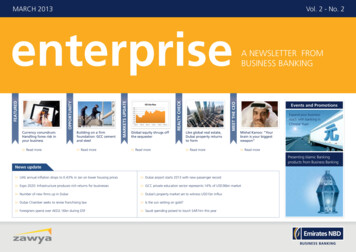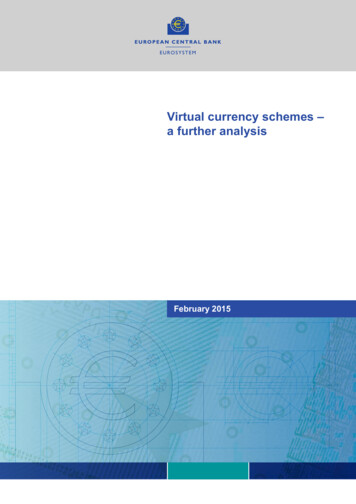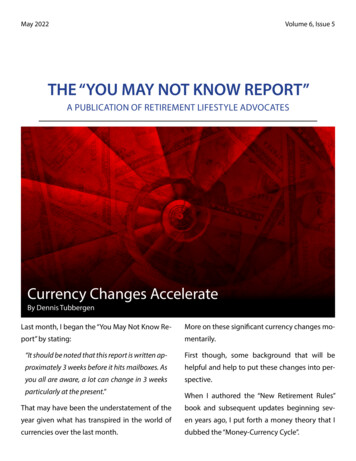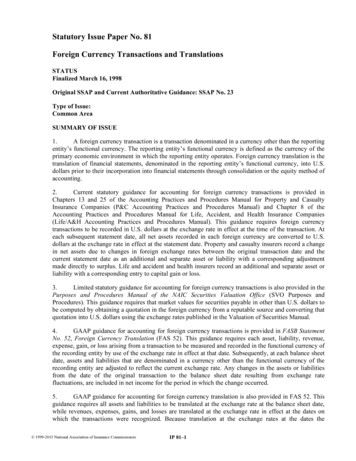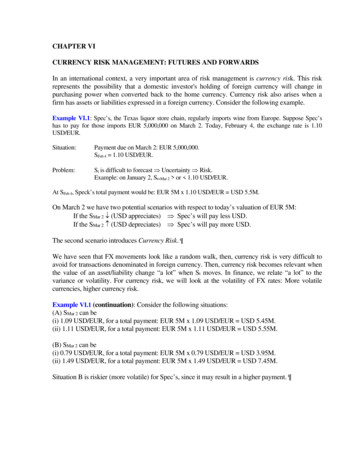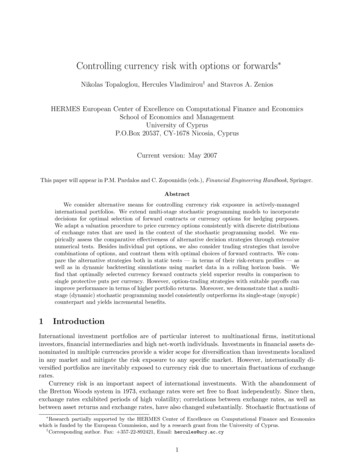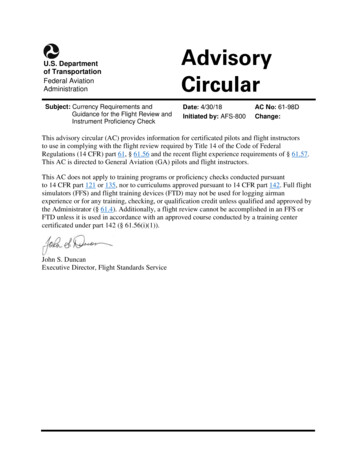
Transcription
U.S. Departmentof TransportationFederal AviationAdministrationSubject: Currency Requirements andGuidance for the Flight Review andInstrument Proficiency CheckAdvisoryCircularDate: 4/30/18Initiated by: AFS-800AC No: 61-98DChange:This advisory circular (AC) provides information for certificated pilots and flight instructorsto use in complying with the flight review required by Title 14 of the Code of FederalRegulations (14 CFR) part 61, § 61.56 and the recent flight experience requirements of § 61.57.This AC is directed to General Aviation (GA) pilots and flight instructors.This AC does not apply to training programs or proficiency checks conducted pursuantto 14 CFR part 121 or 135, nor to curriculums approved pursuant to 14 CFR part 142. Full flightsimulators (FFS) and flight training devices (FTD) may not be used for logging airmanexperience or for any training, checking, or qualification credit unless qualified and approved bythe Administrator (§ 61.4). Additionally, a flight review cannot be accomplished in an FFS orFTD unless it is used in accordance with an approved course conducted by a training centercertificated under part 142 (§ 61.56(i)(1)).John S. DuncanExecutive Director, Flight Standards Service
4/30/18AC 61-98DCONTENTSParagraphPageChapter 1. General . 1-11.1Purpose of This Advisory Circular (AC) . 1-11.2Audience . 1-11.3Where You Can Find This AC. 1-11.4What This AC Cancels. 1-11.5Related 14 CFR Sections . 1-11.6Related Reading Material . 1-11.7Background . 1-21.8FAA Aviation English Language Standard (AELS) . 1-31.9Personal Currency Program . 1-41.10 Airman Certificate and/or Rating Application . 1-51.11 AC Feedback Form . 1-5Chapter 2. Reducing General Aviation Accidents . 2-12.1General Aviation (GA) Accidents . 2-12.2Manual Flight After Automation Failure . 2-42.3Runway Incursion Risks and Avoidance . 2-62.4Flight Instructor Responsibility and Safety Culture . 2-11Chapter 3. Recent Flight Experience . 3-13.1Recent General Experience . 3-13.2Recent Instrument Flight Rules (IFR) Experience. 3-2Chapter 4. Flight Review . 4-14.1Intent and Structure of the Flight Review . 4-14.2Pre-Review Considerations . 4-34.3Planning and Recording the Review . 4-54.4Postreview Considerations . 4-7Chapter 5. Instrument Proficiency Check . 5-15.1Structuring an Instrument Proficiency Check (IPC) . 5-15.2IPC Knowledge Portion . 5-25.3IPC Skill Portion . 5-35.4Post-IPC Considerations and Recordkeeping . 5-4ii
4/30/18AC 61-98DAppendix A. Resources . A-1Appendix B. Sample Airplane Pilot’s Proficiency Practice Plan .B-1Appendix C. Sample Pilot’s Personal Aeronautical Goals .C-1Appendix D. Sample Flight Instructor’s Flight Review Checklist . D-1Appendix E. Regulatory Review Guide. E-1Appendix F. Sample Flight Review Checklist . F-1Appendix G. Sample Pilot’s Instrument Experience Summary. G-1Appendix H. Sample Instrument Training and Proficiency Plan . H-1Appendix J. Sample Flight Instructor’s Instrument Proficiency Check Checklist . J-1iii
4/30/18AC 61-98DCHAPTER 1. GENERAL1.1 Purpose of This Advisory Circular (AC). This AC provides information to assistGeneral Aviation (GA) pilots, flight instructors, and ground instructors in complying withthe flight reviews required by Title 14 of the Code of Federal Regulations (14 CFR)part 61, § 61.56 and the instrument proficiency check (IPC)/recent flight experiencerequirements of § 61.57. Additionally, this AC provides critical information to enhanceGA safety.1.2 Audience. The primary audience for this AC is GA pilots, flight instructors, and groundinstructors. The secondary audience includes flight schools, collegiate aeronauticalinstitutions, and stakeholders supporting GA pilot safety and training.1.3 Where You Can Find This AC. You can find this AC on the Federal AviationAdministration’s (FAA) websiteat http://www.faa.gov/regulations policies/advisory circulars.1.4 What This AC Cancels. AC 61-98C, Currency Requirements and Guidance for theFlight Review and Instrument Proficiency Check, dated November 20, 2015, is canceled.1.5 Related 14 CFR Sections: Section 61.189, Flight Instructor Records. Section 61.193, Flight Instructor Privileges. Section 61.195, Flight Instructor Limitations and Qualifications. Section 61.413, What Are the Privileges of My Flight Instructor Certificate witha Sport Pilot Rating? Section 61.415, What Are the Limits of a Flight Instructor Certificate with a Sport PilotRating?1.6 Related Reading Material. Flight instructors and airmen under review should referencepractical test standards (PTS) or Airman Certification Standards (ACS) documentsappropriate to the certificates and ratings held by the pilot seeking a flight review or IPCprior to the review. You can find additional information in:1. Aeronautical Information Manual (AIM), official guide to basic flightinformation and air traffic control (ATC) procedures.2. FAA Handbooks: FAA-H-8083-3, Airplane Flying Handbook. FAA-H-8083-15, Instrument Flying Handbook. FAA-H-8083-16, Instrument Procedures Handbook. FAA-H-8083-25, Pilot’s Handbook of Aeronautical Knowledge.1-1
4/30/18AC 61-98D3. Information for Operators (InFO) 15012, Logging Instrument ApproachProcedures (IAP), September 8, 2015.4. FAA ACs (current editions): AC 60-28, FAA English Language Standard for an FAA Certificate Issued Under14 CFR Parts 61, 63, 65, and 107. AC 61-65, Certification: Pilots and Flight and Ground Instructors. AC 61-89, Pilot Certificates: Aircraft Type Ratings (guidance on advanced trainingcriteria, pilot certificates, and aircraft type ratings may also be appropriate if theaircraft being used requires a type rating). AC 61-136, FAA Approval of Aviation Training Devices and Their Use forTraining and Experience. AC 91-73, Parts 91 and 135 Single Pilot, Flight School Procedures During TaxiOperations.5. The FAA, commercial sources, and industry associations such as the AircraftOwners and Pilots Association (AOPA), the Experimental AircraftAssociation (EAA), the General Aviation Manufacturers Association(GAMA), and the Society of Aviation and Flight Educators (SAFE) makemany additional sources of media on pilot currency and qualificationavailable.1.7 Background.1.7.1 Regulatory Review. In 1997, the FAA initiated a major regulatory review and updateof 14 CFR parts 61 and 141 to ensure that these regulations conformed to the then-currenttechnological and operational environment and to address future pilot certification needs.This version of AC 61-98 addresses changes in technology and the operationalenvironment, and their impact on recurrent training and proficiency checks. Edits to thisAC, since the original version, have expanded the scope to include recent flightexperience and IPCs.Note: The FAA no longer uses the term “Biennial Flight Review.” This termimplied that pilots only needed currency training once every 24 calendar-months.The FAA encourages currency training as often as appropriate to a pilot’sindividual needs. Consequently, the FAA now uses the term “Flight Review.”1.7.2 GA Pilots. The FAA supports initiatives designed to encourage voluntary compliancewith existing regulations and to maintain and further improve the GA safety record witha minimum of new regulations. As a result, the FAA has determined that updatedadvisory guidance is necessary with respect to the currency, proficiency, andqualification needs of GA pilots. The guidance contained in this version of AC 61-98provides such information and accomplishes the goals of the personal currency program,flight review, and IPC.1-2
4/30/18AC 61-98D1.7.3 Reducing GA Accidents. The FAA added important General Aviation Joint SteeringCommittee (GAJSC) findings and recommendations to AC 61-98 pertainingto GA accidents (see paragraph 2.1).1. GA pilots should become aware of this information and apply it to theirpersonal currency program plans of action.2. Flight instructors should apply this information to their training and evaluationplans of action.1.8 FAA Aviation English Language Standard (AELS).1.8.1 FAA Regulatory English Language Eligibility Requirements. AELS directly affects flightsafety. Regulations require pilots to meet and maintain English language skillrequirements for all grades of pilot certificates issued under part 61. When a flightinstructor conducts a flight evaluation and/or flight training event, the flight instructorshould identify any pilot who does not meet English language skill requirements and takeappropriate action. Finally, all training, checking, or evaluation will be conducted inEnglish. AC 60-28 provides information and guidance regarding English languagestandards required by part 61.1.8.2 Flight Instructor Evaluation. The IPC and the flight review are both evaluations ofa pilot’s ability to conduct a safe flight. Safety-related issues concerning languagebarriers to communications may arise if a pilot does not meet FAA English language skillstandards. A flight instructor should continually evaluate the pilot’s English languageskills during any flight evaluation or training event that he or she conducts and endorsethe individual’s training record or logbook in English for the training and endorsementprovided.1.8.3 Flight Instructor Determination. A flight instructor conducting a flight review or IPCshould not endorse the evaluation as satisfactorily completed if he or she determines thatthe pilot under review does not meet FAA English language skill standards. When a pilothas not accomplished a flight review satisfactorily, the evaluating instructor shouldendorse the pilot’s logbook to indicate only the training received (as is the case with anyunsuccessful flight review). There is no provision in the regulation for the failure ofa flight review; therefore, there should be no logbook endorsement reflecting a failure.In the event the flight review is not successful, due to the flight instructor’s doubt that thepilot under review meets FAA English language skill requirements, the flight instructorshould provide a logbook entry for training received, advise the pilot of the flightinstructor’s finding, and notify his or her responsible Flight Standards office for furtheraction. See paragraph 1.8.4 for additional flight instructor actions.1.8.4 Responsible Flight Standards Office Evaluation. Although the FAA expects flightinstructors to be aware of and follow the guidelines provided in AC 60-28, the FAAdoes not expect flight instructors to be responsible for a conclusive evaluation of anairman’s ability to meet the FAA AELS. Only an FAA aviation safety inspector (ASI)can determine if an applicant, student, or certificated pilot meets the FAA regulatoryEnglish language eligibility requirements. However, if a flight instructor questions the1-3
4/30/18AC 61-98Dability of the airman under training or evaluation to read, speak, write, and understand theEnglish language at a level that meets FAA English language standards, then that flightinstructor must refer the airman to the responsible Flight Standards office for evaluationby an FAA ASI. Thus, the FAA ASI will make the determination. The flight instructorshould also provide the airman’s contact information to the responsible Flight Standardsoffice.1.9 Personal Currency Program.1.9.1 Currency Criteria. Pilots should design a currency program tailored to their individualoperating environments and needs, which should emphasize proficiency beyond theminimum currency requirements. In most cases, pilots may integrate currency criteriawith normal operations to reduce the need for separate currency flights. For example,pilots could incorporate additional takeoffs and landings, instrument approach procedures(IAP), or specialized takeoffs and landings, such as short or soft field, into a plannedflight. In most cases, pilots should consider the need for currency beyond that specifiedby 14 CFR.1.9.2 The FAA Safety Team (FAASTeam). The FAA strongly encourages pilots to participatein the FAASTeam’s Pilot Proficiency Program (WINGS), which includes numerousforms of training media such as online programs and recommended topics for pilotsto review with flight instructors. Additionally, the FAASTeam conducts safety seminars,which are open to the public. You can find the FAASTeam website athttps://www.faasafety.gov/.1.9.3 Aviation Publications and Commercially Developed Materials. Pilots should also explorethe wide range of publications and other commercially developed materials available foruse in personal currency programs. To ensure staying up to date in regulatory changesand flying techniques, the FAA also encourages pilots to read aviation periodicalson a regular basis.1.9.4 Additional Sources for Developing a Personal Currency Program. For assistancein developing a personal currency program, pilots may consult a wide variety of sources.These sources include: Pilot examiners, Pilot schools, Individual flight instructors, FAASTeam Program Managers, and FAASTeam representatives.Note: For information on local sources, pilots should contact their FAASTeamProgram Manager at the responsible Flight Standards office. You can find yourresponsible FAASTeam Program Manager in the FAASTeam Online Directory .aspx. You can find your1-4
4/30/18AC 61-98Dresponsible Flight Standards office at http://www.faa.gov/about/office org/field offices/fsdo/. You can find FAASTeam activities, courses, seminars, andwebinars, plus other free FAA resources, at http://www.faasafety.gov/.1.10 Airman Certificate and/or Rating Application.1.10.1 Revised Airman Application Form. The FAA frequently updates FAA Form 8710-1,Airman Certificate and/or Rating Application, to meet the needs of the airmancertification process and the aviation community. Flight instructors, pilots, andstakeholders should note that the latest FAA Form 8710-1 contains enhancements thatinclude a new field for a flight review and another for IPC.1.10.2 Flight Review and IPC. When a pilot satisfactorily completes a flight review or IPC, theapplicant should provide, and the evaluating flight instructor should submit, a completedFAA Form 8710-1 to the Airmen Certification Branch (AFB-720). The FAA does notrequire FAA Form 8710-1 for a pilot’s flight review or IPC; however, the FAA stronglyencourages all applicants and flight instructors to follow this recommendation. Whensubmitted, AFB-720 will add the application to the pilot’s FAA record. Pilots shouldensure that their data is current, because up-to-date records benefit everyone.For example, a pilot’s total flight time and aeronautical experience determines insurancepremiums. If a pilot loses his or her logbook, an FAA record is on file and available.Nevertheless, submitting FAA Form 8710-1 for a flight review or IPC is optional.1.10.3 Preferred Method. The preferred method for submitting an Airman Certificate and/orRating Application is through the Integrated Airman Certification and/or RatingApplication (IACRA) system. IACRA is the web-based certification/rating applicationthat guides the user through the FAA’s airman application process. IACRA validatesdata. It also uses electronic signatures to protect the information’s integrity andeliminates paper forms. You can find IACRA at https://iacra.faa.gov/IACRA. You can find FAA Form 8710-1 at http://www.faa.gov/forms/.1.11 AC Feedback Form. For your convenience, the AC Feedback Form is the last pageof this AC. Note any deficiencies found, clarifications needed, or suggestedimprovements regarding the contents of this AC on the Feedback Form.1-5
4/30/18AC 61-98DCHAPTER 2. REDUCING GENERAL AVIATION ACCIDENTS2.1 General Aviation (GA) Accidents. The General Aviation Joint Steering Committee(GAJSC) is the primary vehicle for government–industry cooperation, communication,and coordination on GA accident reduction. GAJSC findings reveal common pilot errors,while GAJSC recommendations provide mitigation strategies to reduce GA fatalities.Pilots and flight instructors should apply GAJSC findings and recommendations to theirplans of action as they pertain to personal currency programs, pilot proficiency training,flight reviews, and instrument proficiency checks (IPC). For these reasons, the FAAencourages pilots and flight instructors to keep informed on GAJSC findings andrecommendations. You can find additional information about the GAJSC online athttp://www.gajsc.org/.2.1.1 Loss of Control (LOC). The GAJSC cites LOC as one of the six most critical andcommon causes of GA accidents. Further, LOC was the number one causeof GA fatalities from 2001 through 2010. LOC refers to aircraft accidents that result fromsituations in which a pilot should have maintained (or should have regained) aircraftcontrol, but failed to do so. In some cases, training accidents occurred because the pilotswere not in agreement as to who should be manipulating the flight controls.A recommended three-step process of exchange includes a verbal handoff from the pilotflying, verbal acceptance by the pilot taking over, and a verbal and visual confirmationthat the exchange has taken place by the pilot relinquishing control. This procedureshould be briefed before flight, and include a method to relinquish and take control of theaircraft when normal communications are not possible (e.g., tandem cockpit interphonefailure or wind noise). Pilots and flight instructors are encouraged to practice and useaircraft control handoff procedures on every instructional flight. In addition, flightinstructors need to maintain diligence while providing instruction. A flight instructorshould always be in a position to take over control of the aircraft when doubt exists as tothe safe outcome of any maneuver. The FAA reminds pilots and flight instructors toregularly evaluate (and elevate) procedures and skills to avoid, recognize, and recoverfrom emergencies such as LOC.Note: Future updates to this AC may address other causes of GA accidents,including aeronautical decision-making (ADM), weather, controlled flight intoterrain (CFIT), and system failure.2.1.2 Pilot Proficiency. Studies have shown that LOC usually occurs when pilots lackproficiency. Conditions exceeding personal skill limitations can present themselvesat any time and can occur unexpectedly. In this event, the pilot should be able to avoidbeing startled, make appropriate decisions in a timely manner, and be able to exerciseskills at a proficiency level he or she may not have maintained or attained since acquiredduring initial training. This makes personal currency programs and proficiency trainingessential. Personal currency programs serve to develop and maintain pilot proficiency bypromoting attributes such as aeronautical knowledge, aeronautical skill, and ADM. Theseattributes collectively determine the degree of aeronautical ability a pilot possesses.Highly proficient pilots are better able to avoid or manage an in-flight emergency ina safe and efficient manner. Consequently, the GAJSC recommends that pilots place2-1
4/30/18AC 61-98Demphasis on their specific proficiency needs by including training that may exceedregulatory minimum currency requirements.2.1.3 Traffic Pattern Operations.2.1.3.1LOC accidents often occur while pilots are maneuvering at low altitude andairspeed, such as in an airport traffic pattern. Pilots should adopt, and flightinstructors should promote, training programs designed to reduce the risk ofGA accidents in traffic pattern operations. Flight instructors should providetraining to mitigate the three areas of highest risk involving maneuvering anairplane in an airport traffic pattern. The first area is the risk of a departurestall; the second area is the risk of LOC if attempting to return to the fieldafter an engine failure on takeoff; and the third area is the risk of LOC on thebase to final turn.2.1.3.2Flight instructors should emphasize training that ensures that pilots of smallsingle-engine airplanes depart in coordinated flight at the best-rate-of-climbspeed (VY) for normal takeoffs, and maintain this speed to the altitudenecessary for a safe return to the airport in the event of an emergency. Flightinstructors should train pilots of single-engine airplanes not to return to thefield after an engine failure unless altitude and best glide requirements permit.Accordingly, flight instructors should provide training that emphasizes thecorrect speeds at which light twin-piston aircraft depart the runway. Flightinstructors should emphasize that a departure at the best-angle-of-climb speed(VX) is used for obstacle clearance and short-field takeoff procedures.2.1.3.3Flight instructors should also emphasize the risks and potential consequencesof climbing out at speeds less or greater than what is required for a particulartype of takeoff. Flight instructors should train pilots of single-engine airplanesnot to return to the field after an engine failure unless altitude and best gliderequirements permit a safe return. Therefore, flight instructors should notroutinely train pilots to make a 180-degree turn from a simulated enginefailure while climbing. However, this training should occur at a safe altitude.A critical part of conducting this training is for the flight instructor to be fullyaware of the need for diligence, the need to perform this maneuver properly,and to avoid any potential for an accelerated stall in the turn. It is essential fora pilot to know the altitude that will be lost in a 180-degree turn, in thespecific make and model (M/M) flown, if and when a pilot considers turningback to the departure airport at best glide. During the before-takeoff check, theexpected loss of altitude in the turn, plus a sufficient safety factor, should berelated to the absolute altitude at which a turnback may be attempted.In addition, the effect of existing winds on the preferred direction ofa turnback should be briefed.2.1.3.4Flight instructors should also teach pilots to reject an approach and initiatea go-around when the pilot cannot maintain a stabilized approach. The GAJSCrecommends that pilots and flight instructors emphasize stabilized approach2-2
4/30/18AC 61-98Dand landing proficiency and conduct stabilized approaches as a standardpractice. Flight reviews and IPCs should emphasize evaluating a pilot’s ADM,departure skills, and ability to establish and maintain a stabilized approach andlanding, while applying effective crosswind techniques to avoid the risk ofLOC when maneuvering in an airport traffic pattern. Effective scenario-basedtraining, emphasizing ADM, departures, and establishing and maintaininga stabilized approach to a landing, reduces the risk of LOC in an airport trafficpattern. Many of the principles discussed in this paragraph apply tomultiengine aircraft, but do not apply to single-engine operations in themultiengine airplane. Flight instructors should emphasize the correct speeds atwhich light twin-piston aircraft are operated in the traffic pattern and providetraining in response to an engine failure in a variety of situations.2.1.4 Criteria for Stabilized Approaches Conducted in GA Airplanes. Under mostcircumstances, the airplane should be stabilized by 1,000 feet above airport elevationin instrument meteorological conditions (IMC) and by 500 feet above airport elevationduring straight-in approaches in visual meteorological conditions (VMC). Pilots shouldmonitor at least seven major elements that define a stabilized approach in a GA airplane.The FAA considers an approach to touchdown to be stabilized when the airplane meetsall of the following criteria, with only minor deviations:2.1.4.1Glidepath. The airplane is on the correct flightpath. Typically, the glidepathis 3 degrees to the runway touchdown zone (TDZ) (obstructions permitting).2.1.4.2Heading. The airplane is tracking the extended centerline to the runway withonly minor heading/pitch changes necessary to correct for wind or turbulenceto maintain alignment. Bank angle should not exceed 15 degrees on finalapproach.2.1.4.3Airspeed. The pilot maintains a constant target airspeed within 10/-5 knotsindicated airspeed (KIAS), which is usually at, but no lower than, therecommended landing speed specified in the pilot’s operating handbook(POH)/Airplane Flight Manual (AFM), approved placards/markings, or1.3 times the stall speed or minimum steady flight speed at which the airplaneis controllable in the landing configuration (VSO), if not specified.Note: Most small airplanes maintain a speed well in excessof 1.3 times VSO on an instrument approach (pilot’s discretion).An airplane with a VSO of 50 knots has a normal approach speed of65 knots. However, this same airplane may maintain 90 knots(1.8 VSO) while on the final segment of an instrument approach. Pilotsgenerally select an appropriate approach speed for the prevailingweather, aircraft, traffic, and performance conditions, but not less than1.3 VSO. However, aircraft are usually slowed to a normal landingspeed when on the final approach just prior to landing. Refer to theFAA Instrument Flying Handbook (FAA-H-8083-15), Chapter 4,Aerodynamic Factors, page 4-9, paragraph titled Small Airplanes.2-3
4/30/18AC 61-98D2.1.4.4Configuration. The airplane is in the correct landing configuration with flapsas required, landing gear extended, and the airplane in trim.2.1.4.5Rate of Descent. Descent rate is a constant and generally no greater than500 feet per minute (fpm). If a descent greater than 500 fpm is required dueto approach considerations, it should be reduced prior to 300 feet aboveground level (AGL) and well before the landing flare and touchdown phase.2.1.4.6Power Setting. Power setting is appropriate for the airplane configuration andis not below the minimum power for approach as defined by the POH/AFM.2.1.4.7Checklists/Briefings. All briefings and checklists (except the landingchecklist) are completed prior to initiating the approach.Note: For a typical GA piston airplane in a traffic pattern, if theapproach becomes unstabilized below 300 feet AGL, the pilot shouldinitiate an immediate go-around.2.1.5 IMC. Another area where pilots have experienced LOC is while maneuvering in IMC.Vertigo or spatial disorientation has been a significant factor in many aircraft accidents.The common result when a noninstrument-rated pilot inadvertently continues flight intoIMC is spatial disorientation of the pilot and LOC. Pilots who are instrument rated, butnot instrument proficient, are also susceptible. Recovery from LOC in IMC can be nearlyimpossible without skills and competency. Additionally, instrument-rated pilotsmaneuvering in IMC who fail to prioritize pilot workload properly and use CrewResource Management (CRM) or Single Pilot Resource Management (SRM) maybecome inattentive or distracted and lose situational awareness (SA), which too often canlead to LOC. The GAJSC determined that pilots and flight instructors need to emphasizeeffective preflight planning and pilot proficiency to reduce the risk of LOC in IMC.Note: LOC is not limited to the examples prov
FAA-H-8083-15, Instrument Flying Handbook. FAA-H-8083-16, Instrument Procedures Handbook. FAA-H-8083-25, Pilot's Handbook of Aeronautical Knowledge. 4/30/18 AC 61-98D 1-2 3. Information for Operators (InFO) 15012, Logging Instrument Approach Procedures (IAP), September 8, 2015. 4. FAA ACs (current editions): AC 60-28, FAA English Language Standard for an FAA Certificate .
